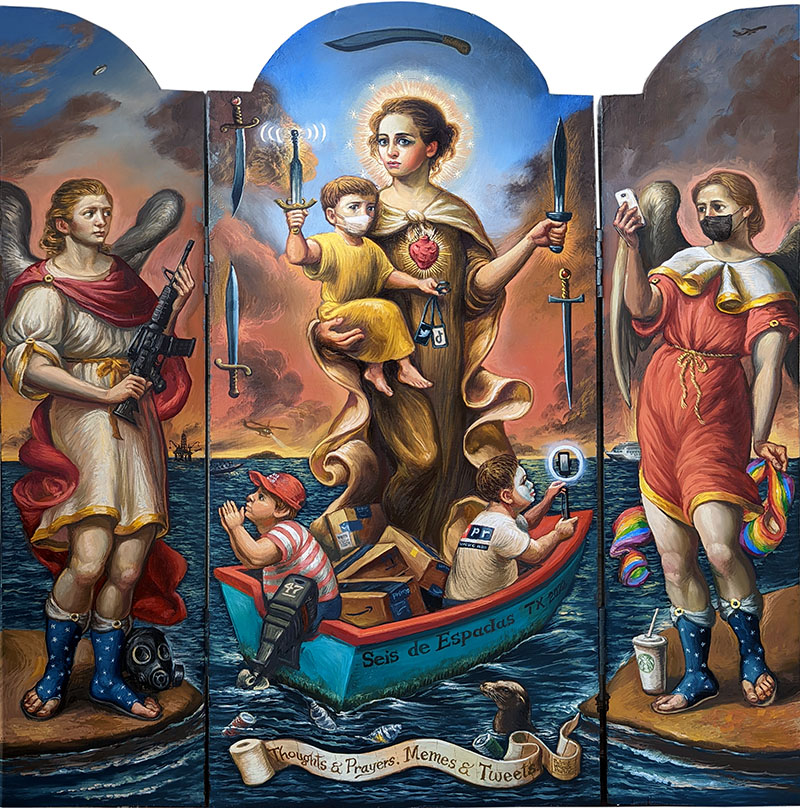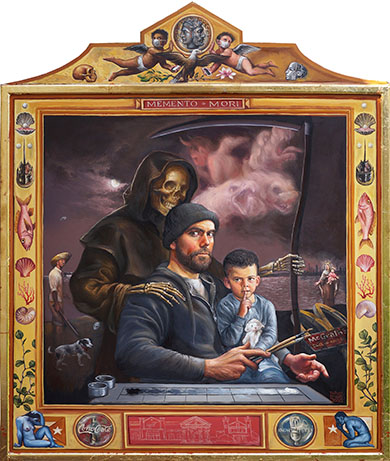Changing Views: From Puerto Rico to Texas

It's been 19 years since I moved to U.S. mainland. It's been 9 years since my wife and I moved to Texas. I was born in New York but grew up in Puerto Rico where I spent most of my childhood and a good part of my youth. After my parents got divorced, my mother, brother, sister and I moved to the island to my mother's hometown of Aguadilla, Puerto Rico. My mom started working as an English teacher while my aunt, who was a retired Catholic nun, took care of me during the day. We lived in a farm that belonged to our grandfather, Francisco (Don Paco). Most of my early memories are shaped by this Caribbean rural setting during the 1980s. At the time I was completely unaware of how much we were permeated by American Consumer culture, specially through fast food, cars, strip malls and cable TV. Puerto Rican culture is quite distinctive. I remember visiting old plazas, tropical rain forests, and museums, and admiring the colonial art of José Campeche, which was quite cathartic. At the time I assumed both of these worlds blended in perfectly well. In time I saw imminent contradictions and a cultural clash that placed my own perceived identity at a crossroads.
In the early 1990s I went on to study at the Escuela de Artes Plasticas in San Juan where I obtained a BFA in Fine Arts. After working some years as a professional artist and nearing my thirties, I decided it was time to come to the U.S., meet my father in person, get to know my family on my father's side and also pursue an MFA at the Savannah College of Art and Design in Savannah, Georgia. This move had a profound impact not only in my life but also in my art. It made me more mindful of where I came from and changed the way I viewed Puerto Rican history, American culture and my relation to both. I never considered myself 100% Puerto Rican but being half Irish American, half Puerto Rican gave me a different perspective on the issue of colonialism, which has been front and center of politics and the arts in the island. Puerto Rico is the oldest colony in the Western hemisphere. After being claimed by the Spanish Crown in 1508 it was later occupied and claimed by the U.S. during the Spanish American war in 1898. To this day it is a non incorporated U.S. territory. Called a Commonwealth, that term is regarded by many as a euphemism for Colony.
This became the basis for my Master's thesis titled Iconsumer: Icons for a consumerist postcolonial age. In my thesis show I presented retablo paintings and triptychs that explored the relationship between traditional Christian icons inspired after Spanish colonial art and our modern day American consumerist society. The use of the retablo altarpiece painting with Renaissance painting techniques allowed me to emulate earlier indoctrination strategies and devices reminiscent of the time of the conquest and colonization of the Americas in order to link them to the past and present them as purveyors of current capitalist and consumerist propaganda. This re-contextualization allowed me to question today's assumptions about the demise of colonialism. It also responded to our globalized neo-liberal economy with its set of consumerist values and environmental indifference by tracing its origins to the time of Columbus.
After graduating from SCAD, I embarked on this creative exploration and took it further by appropriating figures and icons not just from Latin American history, Catholic iconography and American pop culture but also ancient mythology, astrology and tarot. Through satirical narratives and anachronisms I was able to comment and shed light on the myths and colonial roots of the ruling corpocracy with its neo-colonial ramifications.
In the aftermath of hurricane Maria in 2017, I lost my home and main art studio in Puerto Rico. To this day, I still carry with me this deep sense of loss. This did not stop me from making more art, though. On the contrary, it compelled me to create even better work imbued with a personal sense of responsibility to retell our current global paradigm the way I know best, through drawings, paintings, altarpieces and in the form of tarot cards. This was inspired after one of the few personal items I managed to salvage before the storm, my first tarot cards from 30 years ago. Tarot, a deck of divination cards and visual tradition derived from Renaissance culture, offers lessons from the past, while attempting to forecast the future through the use of timeless allegories and occult symbolism. Beyond that, they also point towards a universal set of archetypes that allows us to reinterpret our current age from a holistic perspective, viewing world history as cyclically interconnected.
Even though most of my artwork was lost after Maria, perhaps the most important thing I was able to bring back with me from the island was my experience as an artist. Making art is ultimately what connects me back to Puerto Rico. Sketching in my journals, mixing paint and the scent of oils immediately trigger memories from my life in the island. When I make art, I'm transported back in time to my first art classes in my hometown of Aguadilla and to my old home and studio, now gone and living only in memories. With most of my family, neighbors, friends and even places now vanished or dispersed by time and storms, their memory still lingers in what I create every day.
With that said, I'm also mindful of my present circumstances. After returning to my studio in Houston I also became more aware of my surroundings, realizing this is now my new home. Freeways, bypasses, flooded cityscapes and the occasional longhorn bull started showing up in my paintings. New experiences were now informing my work. After all these years I now feel roots gradually growing into the Lone Star State. Living here has broadened my views and expanded my horizons. The expansive nature of the land and living in a highly multicultural city has opened my eyes to other views. Today, I feel that waking up and realizing we are all connected and share a common home is essential in narrative art. We all live in a small island called Earth. No matter where we stand, we are all affected in one way or another by stronger storms like Harvey and Maria, exacerbated by climate change. No matter where we stand, we live in uncertain times with the rise of AI, nuclear threat and global pandemics. We are also experiencing intensifying culture wars and polarizing mass media in an age of saturated information technology. From our individual points of view, the world may seem like a big place but from where I stand, it's starting to look more like a colonial island with divided tribes experiencing many of the same big issues.

In 2018 my son, Francis was born. This tremendous experience of being a father changed my vision of the world perhaps even more than any other thing in life. A deep sense of connection, understanding, love and protection seeped into my work. The void and absent image of the father figure became filled by myself. Identifying with this archetype for the first time in life definitely changed my views on many issues. It helped me heal, reconcile many internal conflicts and negative biases that had become projected onto exterior figures. As a painter, and after some deep introspection, I now see nothing as truly black and white but rather a complex spectrum of hues, perspectives and views. I've learned to accept, learn and embrace "the opposites," because I am in some ways an embodiment and expression of some of these perceived polarities. Much of our views on politics, religion and the world at large are greatly influenced by friends, family and other people around us. There's a sense of tribe, community and belonging that often informs the way we think about any issue and this seems to be driving much of our current political discourse. Aware of the complexity of this inescapable predicament, I've embraced my creative impulse of recreating scenes that reflect my contradictory sense of identity while remaining open to other viewpoints and change.
It's been 9 years since I started living and making art in Texas, but I still didn't call it home. I now find myself living in a new home in New Territory, Texas and it feels like a completely new chapter in my life. New chapters require new art to go with them. The result of my new work is a set of two-dimensional contemplative sanctuaries that blend personal myths and memories with modern history and religious icons in order to reflect on how our capitalist doctrines, corporate ideologies, and consumerist habits have modified our appreciation towards spirituality, history, nature and ourselves. Ultimately I make art as a way of knowing myself, as a means of understanding the world around me, and as an antidote to our intolerable collective amnesia and superfluous distracted media that keep us disconnected from reality.

Patrick McGrath Muñiz is an artist from Puerto Rico, working primarily with oil paintings on canvas and retablos. His work is inspired by Old Master, Spanish colonial paintings and American Pop Culture while addressing issues such as colonialism, consumerism and climate change. He obtained a BFA (Magna Cum Laude) in Fine Arts from the Escuela de Artes Plasticas in San Juan, Puerto Rico in 2003. After graduating (Suma Cum Laude) from the Savannah College of Art and Design in Savannah, Georgia in 2006, Patrick starting showing his work more within the United States and abroad. Solo shows have included the Museo de las Americas, San Juan; Museo Convento Las Capuchinas in Antigua, Guatemala; Mesa Contemporary Arts Museum, Arizona; and the Fort Worth Community Arts Center, Texas. Patrick's work can be found in collections at the National Hispanic Cultural Center, Albuquerque; the Albuquerque Museum; the Spanish Colonial Arts Museum, Santa Fe; and the Mesa Contemporary Art Museum, Mesa, Arizona as well as a number of private collections in the United States, Europe, Latin America and the Caribbean. Patrick lives and works from New Territory, Texas, with his wife Blanca and son Francis.



